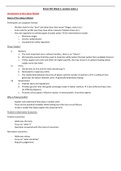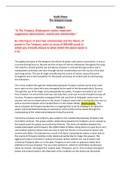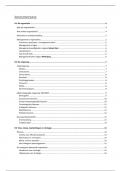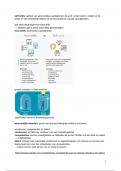Comparative Anatomy and Physiology of Animals
Lecture 1: Welcome and Taxonomy and Systematics 13/10/20
Background
- Each organism has been recognised by scientists and is given a unique scientific name-
binomial nomenclature.
- System destroys ambiguity associated with common names.
- Taxonomy brings together species which resemble each other and to which extent different
species share characteristics and will dictate what point they are linked.
Definitions
- Taxonomy- naming of species typically associated with the original description of species.
- Nomenclature- assignment of a distinctive name to a species.
- Taxon/clade- any grouping of species that share a particular set of characteristics.
- Systematics- study of the kinds and diversity of organisms and the evolutionary relationship
between them .
- Sub-species- diversity of a species based on geographical variation.
Classification
- Domain, kingdom, phylum, class, order, family, genus, species.
- Domain- rRNA has been used to suggest 3 evolutionary lineages called domains.
- Kingdom- cellular organisation has been used to suggest 5 kingdoms.
- Class- morphology and genetic organisation has been used to define lower levels of
classification.
Taxonomy
- Taxonomy relies on morphological characteristics to assign animals to a particular species.
- Recent developments in molecular biology have allowed advances in systematics.
- Comparison of shared DNA and RNA sequences allows a family tree to be created to identify
a common ancestor.
Descriptions
- Monophyletic- has a single ancestral species and all its descendants.
- Polyphyletic- has species that can be traced back to several ancestral species.
- Paraphyletic- has some but not all species in a lineage. (Last two are displays of insufficient
data).
Degrees of relatedness
- Homology: Organ of one species has the same developmental origin in another species but
has a different function in the adult. Implies a relationship between organisms with the same
feature and is the basis for comparative anatomy.
- Analogy: organ of one species has the same function as another unrelated species. Implied
adaptation to similar environment.
Types of symmetry
- Asymmetry – absence of a central point or axis around which the body parts are arranged
- Radial symmetry – one point of reference at the end of the animal that has the mouth and
the other is the opposite point of the animal - Sea anemone
- Bilateral symmetry – arrangement of body parts divides an animal into right and left mirror
images
- Movement of animal in one direction leads to sensory organs at one end – “cephalisation”
Lecture 1: Welcome and Taxonomy and Systematics 13/10/20
Background
- Each organism has been recognised by scientists and is given a unique scientific name-
binomial nomenclature.
- System destroys ambiguity associated with common names.
- Taxonomy brings together species which resemble each other and to which extent different
species share characteristics and will dictate what point they are linked.
Definitions
- Taxonomy- naming of species typically associated with the original description of species.
- Nomenclature- assignment of a distinctive name to a species.
- Taxon/clade- any grouping of species that share a particular set of characteristics.
- Systematics- study of the kinds and diversity of organisms and the evolutionary relationship
between them .
- Sub-species- diversity of a species based on geographical variation.
Classification
- Domain, kingdom, phylum, class, order, family, genus, species.
- Domain- rRNA has been used to suggest 3 evolutionary lineages called domains.
- Kingdom- cellular organisation has been used to suggest 5 kingdoms.
- Class- morphology and genetic organisation has been used to define lower levels of
classification.
Taxonomy
- Taxonomy relies on morphological characteristics to assign animals to a particular species.
- Recent developments in molecular biology have allowed advances in systematics.
- Comparison of shared DNA and RNA sequences allows a family tree to be created to identify
a common ancestor.
Descriptions
- Monophyletic- has a single ancestral species and all its descendants.
- Polyphyletic- has species that can be traced back to several ancestral species.
- Paraphyletic- has some but not all species in a lineage. (Last two are displays of insufficient
data).
Degrees of relatedness
- Homology: Organ of one species has the same developmental origin in another species but
has a different function in the adult. Implies a relationship between organisms with the same
feature and is the basis for comparative anatomy.
- Analogy: organ of one species has the same function as another unrelated species. Implied
adaptation to similar environment.
Types of symmetry
- Asymmetry – absence of a central point or axis around which the body parts are arranged
- Radial symmetry – one point of reference at the end of the animal that has the mouth and
the other is the opposite point of the animal - Sea anemone
- Bilateral symmetry – arrangement of body parts divides an animal into right and left mirror
images
- Movement of animal in one direction leads to sensory organs at one end – “cephalisation”










